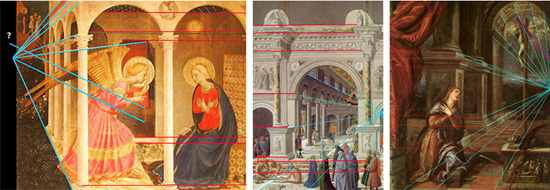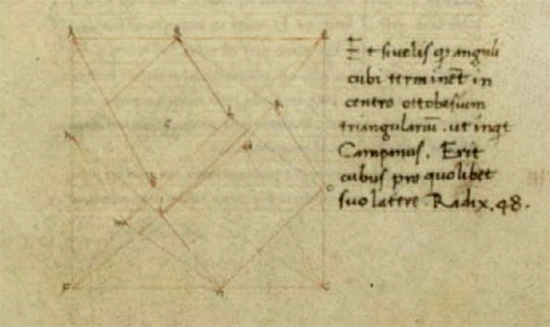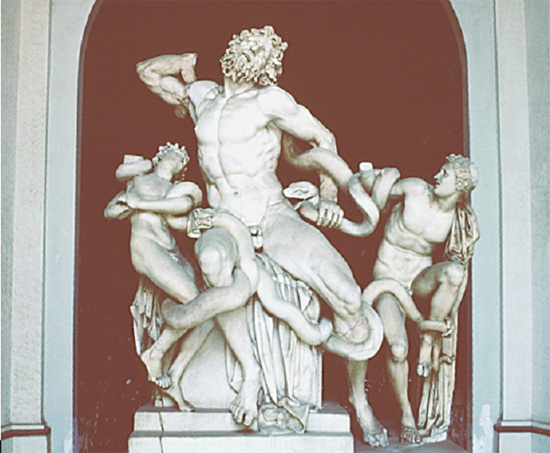The Role of Perspective in Shaping the Renaissance
Thus, ‘The Disputation of St Stephen’ is typical of the classical
Renaissance in retaining the parallels for the transverse lines when the vanishing
point is shifted over to the one side of the picture. These transversals are
captured in this instance by the horizontal supporting struts under the arches
(and also the line of the bases of the nearest pillars). The horizontals would
be parallel to the canvas if the vanishing point were centered, but should
rotate back at the left side when the vanishing point is shifted to the right.
The horizontals should then converge to an appropriate vanishing point at
right, but this necessity was not evident to any of the Renaissance artists
surveyed, as in the three further examples from the early Renaissance in Fig.
9.
 |
| Fig. 9. Three examples of paintings
in one-point perspective with laterally shifted vanishing points. Left
panel. ‘The Annunciation’ by Fra Angelico (1436-1443); central
panel: ‘Presentation of the Virgin’ by Fra Carnevale (1467);
right panel: ‘The Vision of St. Catherine’ by Titian (1503?). |
 |
The turquoise lines in Fig. 9 show the convergence of receding horizontals
to a vanishing point at the edge of the picture in each case. The red lines
show the horizontals physically at right angles to the first set. For accurate
perspective viewed from the center of the canvas, this second set should converge
to some point beyond the other side of the frame, but they clearly remain
parallel. This forced one-point construction remained the perspective convention
for about two centuries. It is perceptually very effective, probably because
we are used to inferring the shapes of objects from the default that depicted
angles are likely to be right angles. The default to right angles allows a
robustness to distortion (to use Kubovy’s phrasing). Retention of the
parallelism when the vanishing point is shifted corresponds to the depiction
of rhomboidal rather than rectangular building plans (like the John Hancock
Building in Boston, for example). The perspective would be accurate for this
unusual kind of architecture, but it is most unlikely that the Renaissance
artists were intending to depict such non-rectangular structures. It seems
clear that they were depicting rectangular buildings and felt that the vanishing
point could be safely shifted without evoking the sense of a distorted building.
In fact, they had a rule that the vanishing point could be safely displaced
as long as it did not go not beyond the boundary of the picture frame. This
rule implies an awareness that extreme displacement incurred distortions,
but that the distortions were hardly noticeable within some limited range.
 |
| Fig. ? An oblique view of a cube inscribed
in an octahedron. |
 |
One of the major proponents of the perspective construction in the Quattrocento
was Piero della Francesca, who really laid a firm foundation for the geometry
of one-point perspective in his book ‘De Prospectiva Pingendi’.
There has been discussion of whether Francesca also understood more advanced
projection systems, based on his diagrams such as the oblique view of a cube
from his treatise ‘De quinque corporibus regularibus’ reproduced
in Fig. ? Inspection reveals, however, that this projection is in parallel,
or orthographic, perspective and has no vanishing points. Thus, although Francesca
had a good understanding of the projection of complex objects in three dimensions,
there is no evidence that his perspective knowledge went beyond the one-point
construction with which he is justifiably credited.
 |
| Fig. 10 The Laocoön group, a
Greek sculpture from the Hellenistic period that had a great influence
on Michelangelo’s heroic style. |
 |
By the beginning of the 16th century, it appears that artists felt straight-jacketed
by the central perspective scheme, without realizing the flexibility that
would have been allowed by full perspective with arbitrary vanishing points.
A key moment in this evolution was when Michelangelo was taken by the Pope’s
art advisor, Sangallo, to view sculptures that had just been dug up in the
ruins of Titus’ palace. They immediately identified one of the sculptures
as the Laocoön described by the historian Pliny (see Fig. 10). Michelangelo
often spoke of the effect of the muscular power of this epic struggle on his
artistic development, which acted in turn as a catalyst of the High Renaissance.
